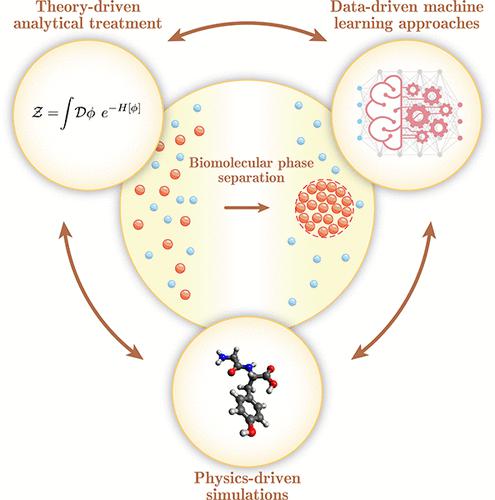当前位置:
X-MOL 学术
›
Chem. Rev.
›
论文详情
Our official English website, www.x-mol.net, welcomes your
feedback! (Note: you will need to create a separate account there.)
Theoretical and Data-Driven Approaches for Biomolecular Condensates
Chemical Reviews ( IF 51.4 ) Pub Date : 2023-05-12 , DOI: 10.1021/acs.chemrev.2c00586 Kadi L Saar 1, 2 , Daoyuan Qian 1 , Lydia L Good 1, 3 , Alexey S Morgunov 1 , Rosana Collepardo-Guevara 1, 4 , Robert B Best 3 , Tuomas P J Knowles 1, 5
Chemical Reviews ( IF 51.4 ) Pub Date : 2023-05-12 , DOI: 10.1021/acs.chemrev.2c00586 Kadi L Saar 1, 2 , Daoyuan Qian 1 , Lydia L Good 1, 3 , Alexey S Morgunov 1 , Rosana Collepardo-Guevara 1, 4 , Robert B Best 3 , Tuomas P J Knowles 1, 5
Affiliation

|
Biomolecular condensation processes are increasingly recognized as a fundamental mechanism that living cells use to organize biomolecules in time and space. These processes can lead to the formation of membraneless organelles that enable cells to perform distinct biochemical processes in controlled local environments, thereby supplying them with an additional degree of spatial control relative to that achieved by membrane-bound organelles. This fundamental importance of biomolecular condensation has motivated a quest to discover and understand the molecular mechanisms and determinants that drive and control this process. Within this molecular viewpoint, computational methods can provide a unique angle to studying biomolecular condensation processes by contributing the resolution and scale that are challenging to reach with experimental techniques alone. In this Review, we focus on three types of dry-lab approaches: theoretical methods, physics-driven simulations and data-driven machine learning methods. We review recent progress in using these tools for probing biomolecular condensation across all three fields and outline the key advantages and limitations of each of the approaches. We further discuss some of the key outstanding challenges that we foresee the community addressing next in order to develop a more complete picture of the molecular driving forces behind biomolecular condensation processes and their biological roles in health and disease.
中文翻译:

生物分子凝聚物的理论和数据驱动方法
生物分子缩合过程越来越被认为是活细胞在时间和空间上组织生物分子的基本机制。这些过程可以导致无膜细胞器的形成,使细胞能够在受控的局部环境中执行不同的生化过程,从而为它们提供相对于膜结合细胞器所实现的额外程度的空间控制。生物分子缩合的这种根本重要性促使人们寻求发现和理解驱动和控制这一过程的分子机制和决定因素。在这个分子观点中,计算方法可以提供一个独特的角度来研究生物分子缩合过程,通过提供单独的实验技术难以达到的分辨率和规模。在这篇综述中,我们重点关注三种类型的干实验室方法:理论方法、物理驱动的模拟和数据驱动的机器学习方法。我们回顾了使用这些工具在所有三个领域探测生物分子缩合的最新进展,并概述了每种方法的主要优点和局限性。我们进一步讨论了我们预计社区接下来要解决的一些关键的突出挑战,以便更全面地了解生物分子缩合过程背后的分子驱动力及其在健康和疾病中的生物学作用。
更新日期:2023-05-12
中文翻译:

生物分子凝聚物的理论和数据驱动方法
生物分子缩合过程越来越被认为是活细胞在时间和空间上组织生物分子的基本机制。这些过程可以导致无膜细胞器的形成,使细胞能够在受控的局部环境中执行不同的生化过程,从而为它们提供相对于膜结合细胞器所实现的额外程度的空间控制。生物分子缩合的这种根本重要性促使人们寻求发现和理解驱动和控制这一过程的分子机制和决定因素。在这个分子观点中,计算方法可以提供一个独特的角度来研究生物分子缩合过程,通过提供单独的实验技术难以达到的分辨率和规模。在这篇综述中,我们重点关注三种类型的干实验室方法:理论方法、物理驱动的模拟和数据驱动的机器学习方法。我们回顾了使用这些工具在所有三个领域探测生物分子缩合的最新进展,并概述了每种方法的主要优点和局限性。我们进一步讨论了我们预计社区接下来要解决的一些关键的突出挑战,以便更全面地了解生物分子缩合过程背后的分子驱动力及其在健康和疾病中的生物学作用。











































 京公网安备 11010802027423号
京公网安备 11010802027423号